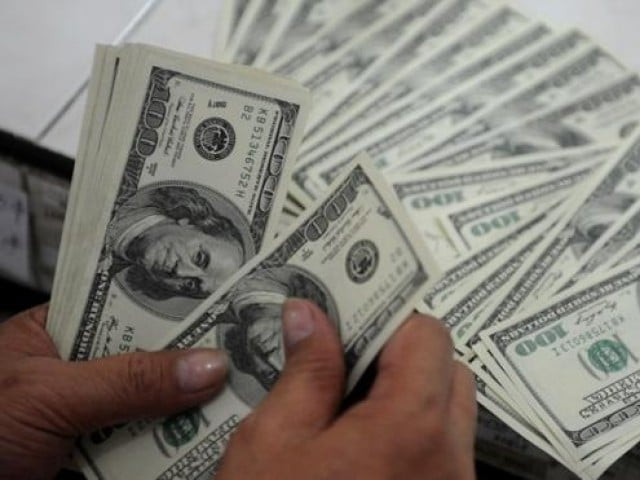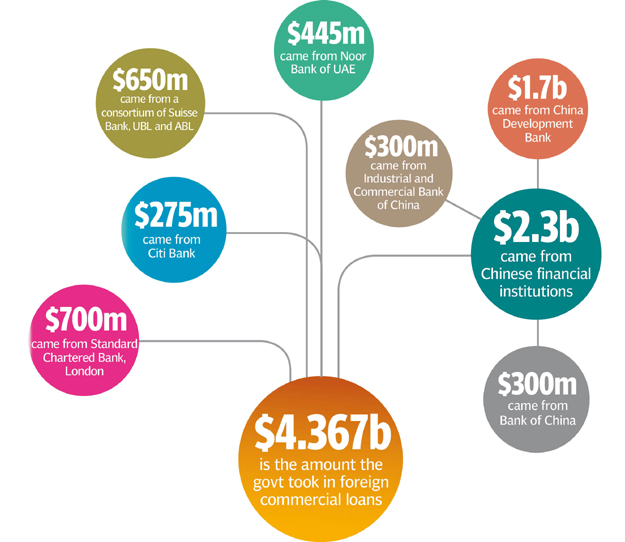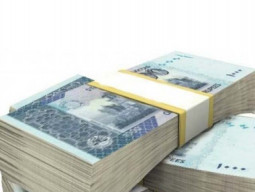
About 37% or $3.9 billion of the total external borrowing came from China alone -Islamabad’s new lifeline. This includes $2.3 billion in commercial loans and another $1.6 billion under the bilateral economic assistance.
The $10.1-billion loans that include a record breaking $4.4 billion short-term foreign commercial loans as well were obtained during fiscal year 2016-17 that ended on June 30, said sources in the Ministry of Finance.
This is the first time in Pakistan’s history that any government has taken over $10 billion as fresh foreign loans in a single year. About $4.4 billion of these loans were used to repay previous loans. The $10.1 billion loans were 26.3% or $2 billion higher than the government’s own estimates it had placed before the parliament in June last year.
Pakistan pays $4.8b in external debt servicing
An alarming factor was the federal government’s growing reliance on short-term foreign commercial borrowings. Against the budgetary estimates of $2 billion, the federal government took whopping $4.367 billion foreign commercial loans. Out of this, $2.3 billion came from Chinese financial institutions. The government took $1.7 billion from the China Development Bank, $300 million from Industrial and Commercial Bank of China, another $300 million from Bank of China. It also obtained $445 million from Noor Bank of UAE, $650 million from a consortium of Suisse Bank, UBL and ABL, $275 million from Citi and $700 million from Standard Chartered Bank, London.

Since the PML-N government came into power, the country’s reliance on non-conventional borrowings has rapidly grown. By including $1 billion Sukuk bonds borrowing, the total non-conventional borrowing in the last fiscal year was equal to 52.5% of the total external loans.
Historically, the bilateral and multilateral modes of foreign financing were the preferred options for the successive governments. However, during the last fiscal year, bilateral loans stood at $2.1 billion and these predominantly came from China which gave $1.6 billion loans under this category. The bilateral economic assistance stood at about one-fifth of the total fresh borrowings.
Similarly, the loans by the multilateral lenders were recorded at $3.13 billion or 29.2% of the total assistance. More than half of the multilateral assistance came from Asian Development Bank that gave $1.6 billion in fresh loans. However, loans from the World Bank stood at $958 million and were only 65% of the government’s budgetary estimates.
One of the main reasons behind the growing reliance on foreign lenders is the government’s inability to enhance exports that have been constantly declining since the PML-N government came into power. In the last fiscal year, the exports stood at only $20.44 billion, which were just 6.7% of the total size of the economy.
However, the foreign direct investment slightly picked to $2.4 billion in the last fiscal year but it was still significantly below the government’s estimates.
Senator Saleem Mandviwalla, former finance minister in the PPP government, said on Wednesday that the government’s policy to borrow more to repay the previous debt could create serious problems for the economy.
During the fiscal year 2016-17 -the current account deficit had widened to $12.1 billion or 4% of the GDP, said the central bank.
To bridge the deficit gap, the government resorted to reckless borrowings as it wanted that the implications on the official foreign currency reserves should be minimal. Still, the central bank held official foreign exchange reserves fell by $2 billion to $16.1 billion by June 30.
Pakistan gets $4.6b in fresh foreign loans
For the new fiscal year 2017-18, the International Monetary Fund has said that Pakistan’s gross external financing requirements would be $16.2 billion. The $16.2 billion figure has been worked out by assuming that the current account deficit will be equal to 3.2% of the GDP or $10.1 billion. The external debt payments including short-term have been estimated at $6.2 billion.
However, former finance minister Dr Hafiz Pasha has estimated that the gross external financing requirements would increase to roughly $19.7 billion. He said that the financing gap will be close to $9 billion, which will either have direct bearing on the official foreign currency reserves are the external borrowings will significantly increase.
For the new fiscal year, the government has again budgeted $8 billion foreign loans.
Pakistan’s gross official foreign currency reserves could slip below $10 billion by end June 2018, said Dr Hafiz Pasha.
Published in The Express Tribune, July 21st, 2017.
Like Business on Facebook, follow @TribuneBiz on Twitter to stay informed and join in the conversation.


















COMMENTS
Comments are moderated and generally will be posted if they are on-topic and not abusive.
For more information, please see our Comments FAQ